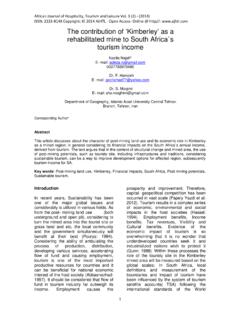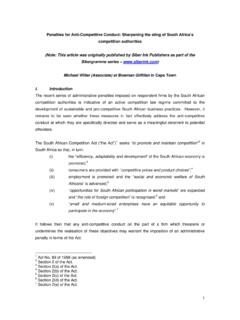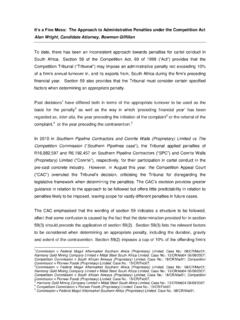Transcription of The aviation industry in South Africa: A historical overview
1 african Journal of Hospitality, Tourism and Leisure Vol. 5 (4) - (2016) ISSN: 2223-814X Copyright: 2014 AJHTL - Open Access- Online @ http//: 1 The aviation industry in South africa : A historical overview Oswald Mhlanga* Hospitality Department, University of Mpumalanga, South africa . and Steyn Department of Tourism and Event Management, Cape Peninsula University of Technology Corresponding author* Abstract The insatiable needs of man necessitated his movement from one place to another and one major means by which he has been doing this is by flying in the aeroplane. The article traces the history of civil aviation in South africa , exploring the various phases of development which the industry has gone through. It concludes that the aviation industry is indispensable to the development of tourism in South africa and should therefore be given the proper attention it deserves.
2 Keywords: Civil aviation , Flying, Tourism, South africa , History. Introduction The main objective of the article is to trace the history of the civil aviation industry in South africa . It explores the genesis of the industry in the colonial period, the birth of South african Airways, the apartheid period and the subsequent post 1992 growth of the industry , as well as the economic impact on South africa . Methodologically the article is based on a literature review supported by interviews with airline operators. aviation practice began in South africa in 1929, barely twenty six years after the Wright brothers first flight in 1903 (Ssamula, 2014:226). Though it started as an airmail operation when Major Allister Miller founded the Union Airways in 1929, it gradually assumed the character of a passenger operation in the decades that followed (Pirie, 2006:9). However, several forms of transportation had existed in South africa before the advent of aviation (Bennett & George, 2004:117).
3 The earliest form of transport (that is, water transport) had been occurring in the coastal areas of South africa and provided avenues for economic exchange (Goldstein, 2001:230). Trade had been conducted between South africa and other countries via the seas for centuries (Ssamula, 2014:226). Naturally, these goods needed to be transported to various locations throughout South africa , leading to the development of roadways in 1854 (Brits, 2010:27). In 1860 the first tracks for steam powered locomotives were laid down by the National Railway Locomotive (Pirie, 1990:237). This track was set to create a link between the city of Durban and the Harbour particularly for the transportation of freight and shipments from the ocean (Brits, 2010:27). Later, the introduction of electric power presented new opportunities to adopt mechanical modes of transport by means of trolley buses as early as 1867 (Lunsche, 1997:9).
4 It promoted ease of travel between residential suburbs and the city centre (Ndlovu, 2001:92). In 1872 Cape Rail construction built a 72km track between Cape Town and Wellington african Journal of Hospitality, Tourism and Leisure Vol. 5 (4) - (2016) ISSN: 2223-814X Copyright: 2014 AJHTL - Open Access- Online @ http//: 2 (Bennett and George, 2004:117). In 1898 although many provinces had started to develop their own tracks, all national networks linked up, creating a national transport network (Pirie, 1990:237). In 1910 the merger of four provinces to form what is now known as South africa and created a more modernised rail network that was managed by the South african Railways and Harbours Agency (Ssamula, 2008:11). Air transport was a late comer to the scene (Ssamula, 2014:226). It was a transport system for the elite and wealthy businessmen; and was not suitable for the carriage of goods and minerals from the hinterland to the coast like the railways (Ssamula, 2008:11).
5 From its very beginning therefore, air transport served as an exclusive preserve of the few (Ogbeidi, 2006:141). Today aviation plays a major role in the tourism industry and makes a huge contribution in South africa s GDP (StatsSA, 2016:7). Its contribution includes direct, indirect and induced impacts, which are related to the total revenues of the air transport industry (SSA, 2015:20). It is against this background that this chapter seeks to discuss the development of the aviation industry in South africa . Early aviation history in South africa (1929-1949) In 1929 Major Allister Miller founded the Union Airways in Port Elizabeth after being awarded a government contract to fly airmail between Cape Town and the major centres in South africa (Pirie, 1990:237). The airline was registered on 24 July 1929 and began airmail operations on 26 August 1929. On 3 September 1929, the Union Airways started carrying passengers (Mutambirwa and Turton, 2000:71).
6 As both mail and passenger traffic increased Miller bought three more aircrafts on 29 May 1930 (Gavin, 2013:9). However, in 1931 two of the Union Airways aircrafts crashed and were written off (Pirie, 1990:237). This marked the beginning of the airlines struggles (Ndlovu, 2001:92). In 1932 the Union Airways struggled to make ends meet and little help was forthcoming from the South african government (Pirie, 1990:237). The final nail in the Union Airways coffin came in 1933 when one of the Union Airways aircraft crashed (Gavin, 2013:9). This was a major blow to the airline and forced Miller to approach the South african government to take over the operation (Ndhlovu and Ricove, 2009:17). The South african government took over the assets and liabilities of the Union Airways on 1 February 1934 (Ndhlovu and Ricover, 2009:17). The airline was named South african Airways (SAA) and fell under the control of the South african Railways and Harbours Administration (SARHA) (Ssamula, 2008:11).
7 Pirie (2006:9) posits that from 1934 the air transport environment in South africa was lightly regulated, though the powerful South african Railways and Harbours Administration (SARHA) sought to protect railway services at the expense of air travel. As a signatory (as part of the British Empire) to the Paris Convention of 1919, the South african air transport regulatory environment was based on the principle of air sovereignty (Ssamula, 2008:11). Gavin (2013:9) avers that during the Second World War (1939-1945) all aircraft employed for civil aviation transport purposes in South africa were transferred to military authorities and the country became totally dependent on foreign airlines for the provision of domestic air transport services. Pirie (1990:238) claims that foreign airlines provided domestic services at very reasonable rates during the war, but fares increased quite substantially after the war.
8 The economic conditions that prevailed after the war could not support these fares and slight decreases were announced in March 1946 (Ssamula, 2008:11). In 1946 a new private airline, Comair was established and started operations (Goldstein, 2001:230). However, to protect SAA, (as the flag carrier) from private airlines such as Comair, the International Air Services Act Number 20 was promulgated in 1949. According to the Act, airlines that wished to compete against SAA on the main domestic routes had to prove, amongst other things, that a need existed and that the incumbent airline was not delivering an african Journal of Hospitality, Tourism and Leisure Vol. 5 (4) - (2016) ISSN: 2223-814X Copyright: 2014 AJHTL - Open Access- Online @ http//: 3 adequate service (Brits, 2010:27). These requirements were outlined in Section 20 of the Act and were virtually impossible to meet in the presence of the domination of SAA (Ssamula, 2008:11).
9 The result was that SAA had complete monopoly on the high-density routes and controlled airports and landing slots (Gavin, 2013:9). Consequently, Comair was relegated to feeder routes (Goldstein, 2001:230). Bennett (2005:419) asserts that since 1948, economic regulation protected SAA s position on the main trunk routes (trunk routes are profitable routes with a high demand) in South africa similar to the protection of railway services provided by the South african Railways and Harbours (SAR&H). SAA was further left to develop the domestic air transport on its own. SAA was part of South african Railways. The Railways was entrusted with the development of a transport infrastructure for South africa . As such, it was an instrument to carry out Government policy. Its business objective was not profitability but meeting the growing transport needs of a fast developing country.
10 The Government protected this investment by shielding it against competition and uneconomical overlapping of services. This meant that SAA was not a true business concern. Certain uneconomical services were maintained for strategic reasons and also for reasons of national economy. Private airlines were not willing to operate these routes, until they were subsidised. The principle of cross-subsidization was accepted and the major routes were required to subsidise the less profitable ones. Being the only scheduled domestic airline, SAA obtained the rights to most of the major routes automatically. The development of air transport took place under these conditions and has led to SA Airways domination in the domestic air travel market (Vlok, 1992:20). The apartheid era (1949-1991) Domestic air services within South africa were regulated in 1949 through the Air Services Act (Act No.)



















